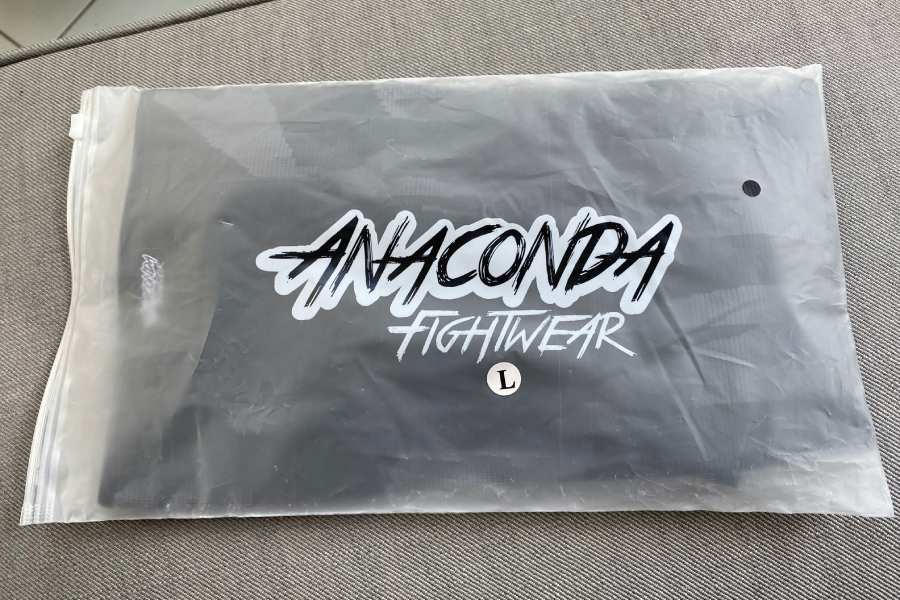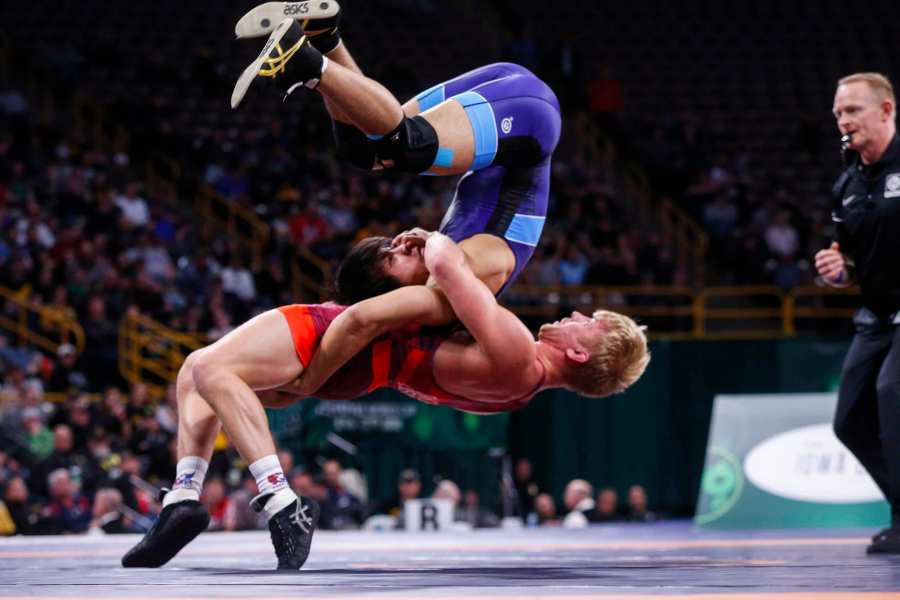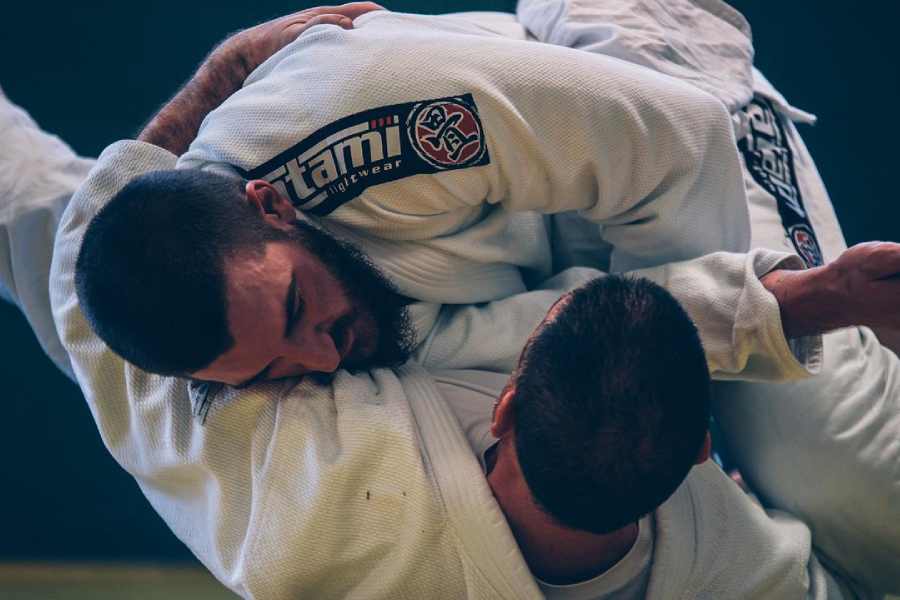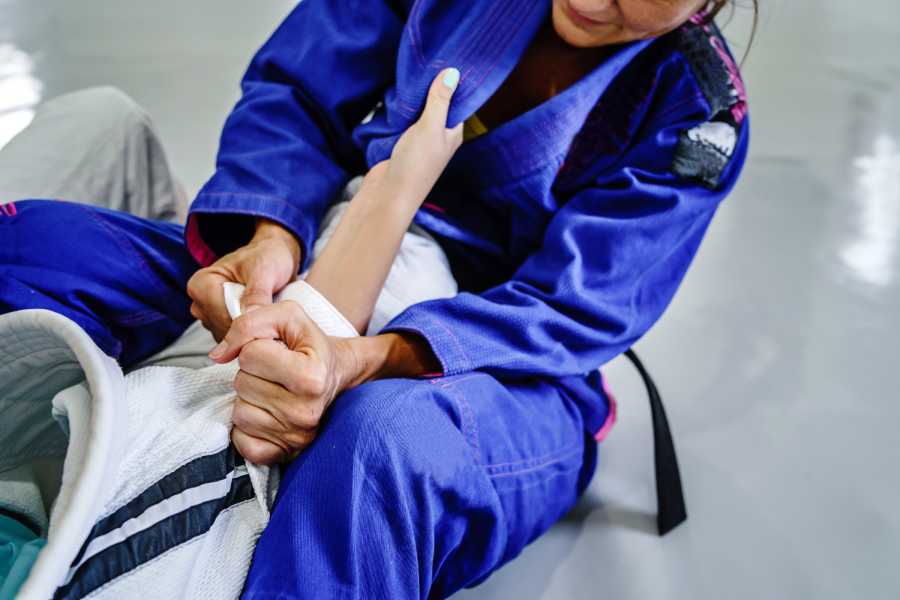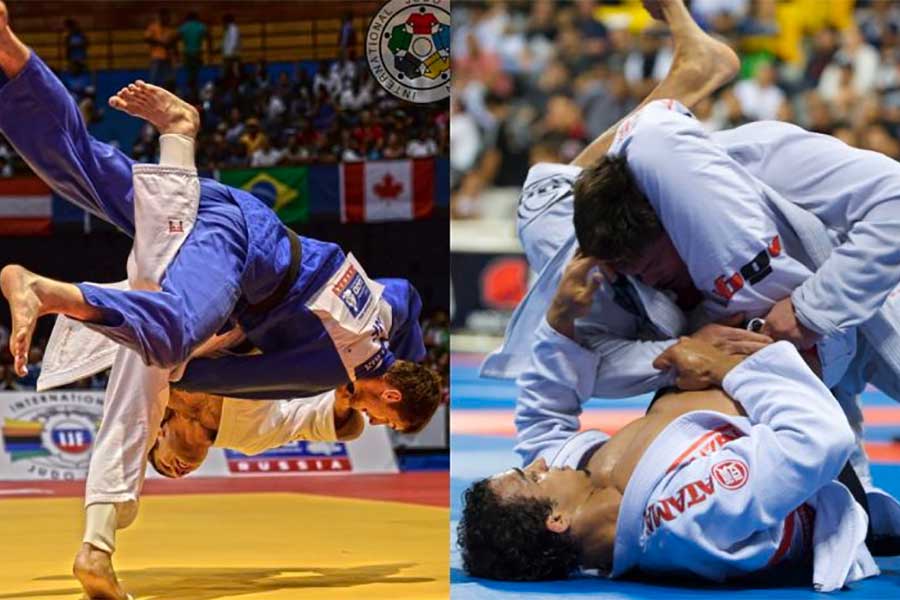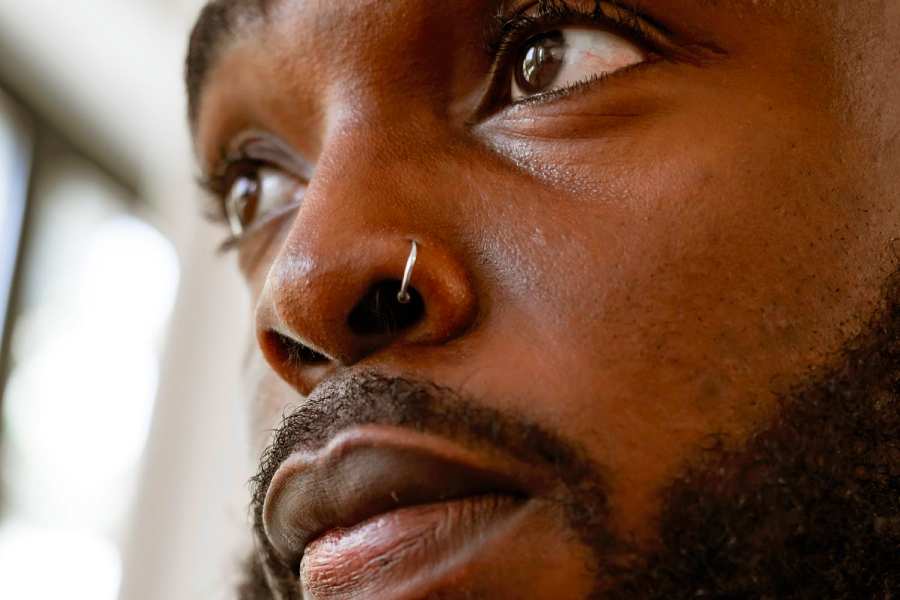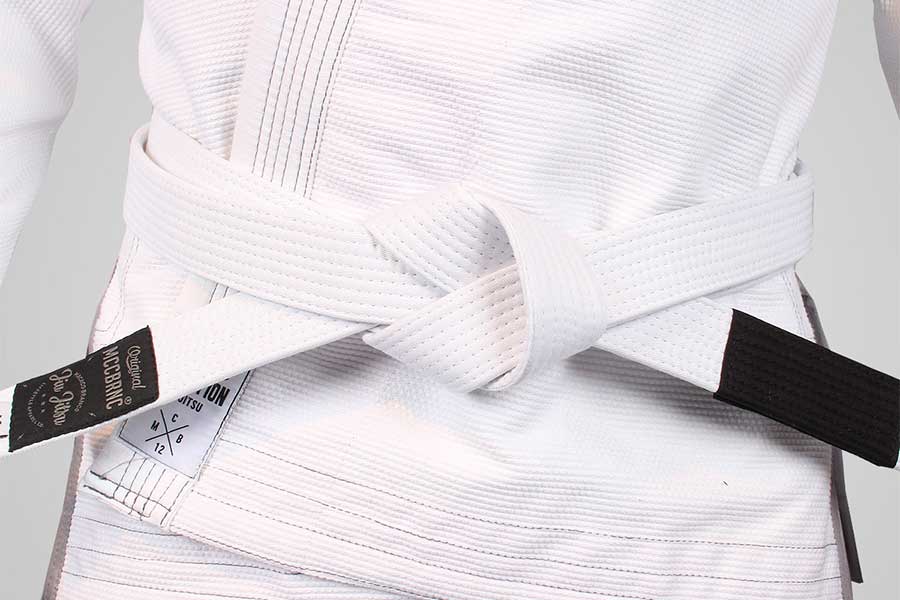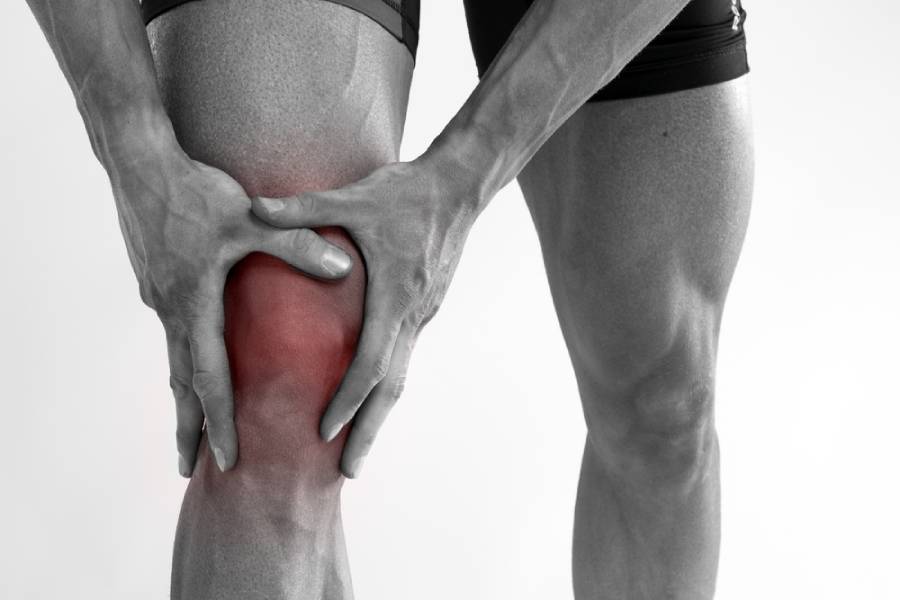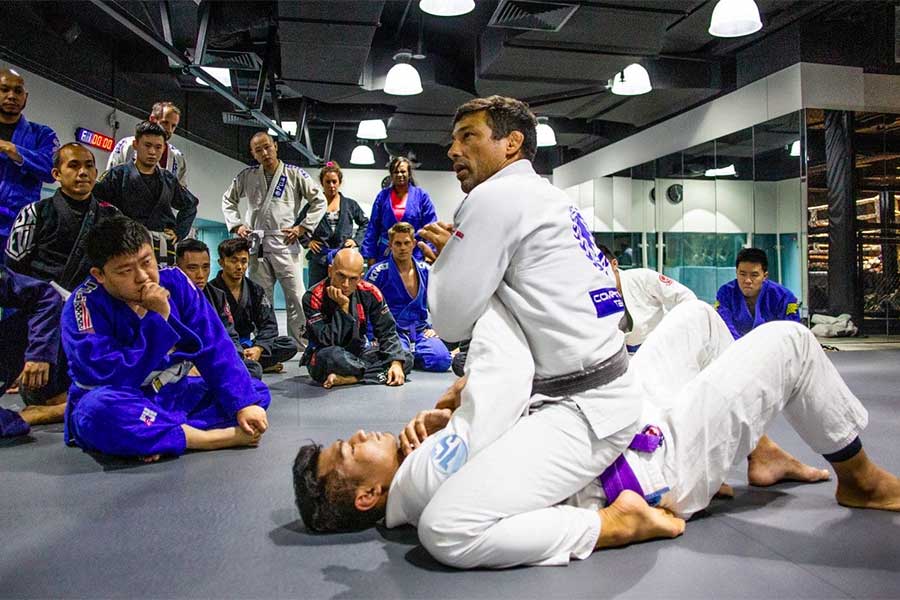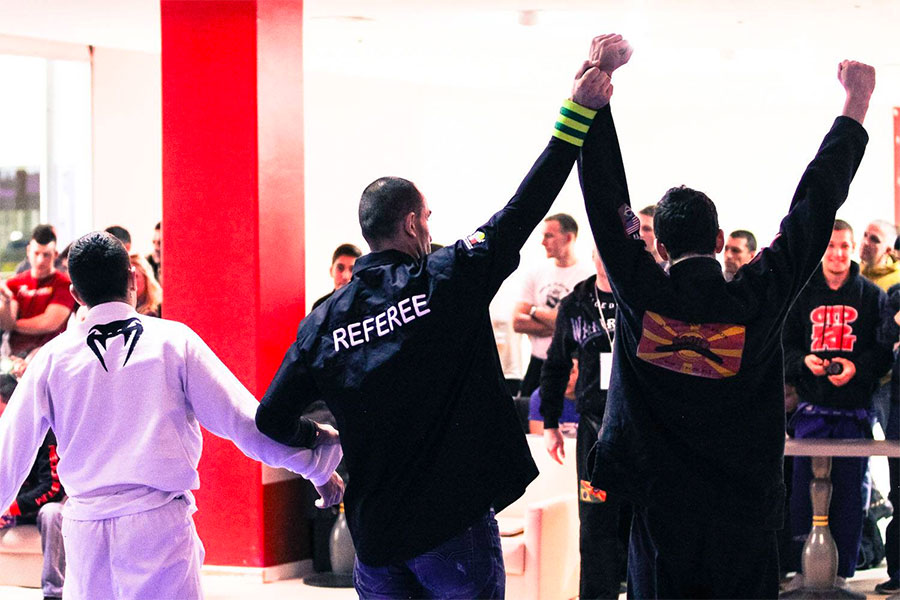Brazilian Jiu-Jitsu has become one of the most popular martial arts in the world, and it’s not hard to see why. From its gentle origins to its explosive presence in MMA, BJJ has proven to be a powerful tool.
With a focus on grappling and groundwork, this martial art It’s all about controlling the position and using leverage to submit the opponent effortlessly.
Whether you’re a die-hard MMA fan or just curious about martial arts, learning the basics of Brazilian Jiu-Jitsu is definitely worth it.
So, get ready for a deep dive into the BJJ basics. Let’s get to it.
Table of Contents
- BJJ Basics – What is Brazilian Jiu-Jitsu?
- What Gear Do You Need For Jiu-Jitsu?
- Gear You Need for No-Gi BJJ
- Equipment Do You Need for Jiu-Jitsu Rolling
- Extra Gear You Might Want When Training BJJ
- The Difference Between Jiu-Jitsu and Brazilian Jiu-Jitsu
- What is Brazilian Jiu-Jitsu Good For?
- The Rules of BJJ – BJJ Fundamentals
- Basics of BJJ Combat
- The Safety of Brazilian Jiu-Jitsu
- Is Jiu-Jitsu Bad For Your Body?
- The Pros and Cons of Jiu-Jitsu
- Common Training Routines
- The Brazilian Jiu-Jitsu Gi and Rankings
- Popular BJJ Competitions
- Tips for BJJ Beginners
- The History and Invention of BJJ
- Helpful Brazilian Jiu-Jitsu Articles You Shouldn’t Miss
- BJJ Basics – Brazilian Jiu-Jitsu For Dummies FAQ
BJJ Basics – What is Brazilian Jiu-Jitsu?
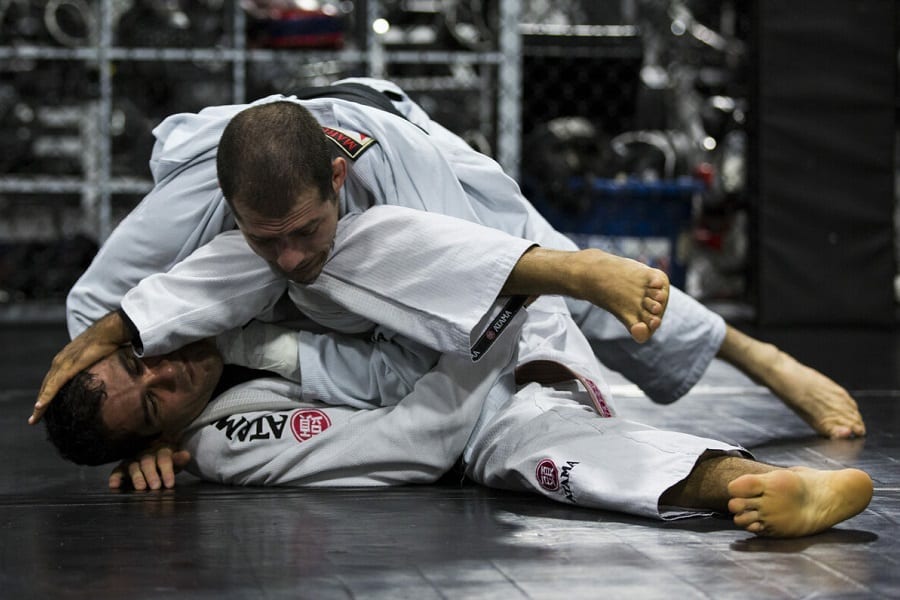
At its core, Brazilian Jiu-Jitsu is a dynamic grappling martial art that teaches you how to use leverage and technique to overcome your opponents.
It emphasizes ground fighting and submission to control and defeat adversaries. BJJ provides a comprehensive set of skills that can be applied in various contexts, from self-defense situations to competitive MMA bouts. You’ll learn things like:
- Judo throws
- Wrestling takedowns
- All sorts of joint locks
- Strangulation techniques
- Sweeps
- Escapes
- How to pin opponents to the ground
What is the goal in jiu-jitsu?
In essence, your goal in Brazilian Jiu-Jitsu is to secure a submission or make your opponent “tap out.” This entails applying a joint lock or a strangulation technique that compels them to surrender. Otherwise, they risk bone injury or experience unconsciousness due to restricted oxygen or blood flow.
To accomplish this, you must familiarize yourself with specific techniques and adhere to a straightforward five-step plan aligned with Jiu-Jitsu’s overarching mission.
- Step 1: Initiate a takedown to bring your opponent to the ground.
- Step 2: Navigate past their legs, commonly referred to as passing their guard.
- Step 3: Gain access to the space between their shoulders and hips, a crucial area in establishing dominant control.
- Step 4: Establish a position of dominant control within that space.
- Step 5: Execute the submission, achieving victory by forcing your opponent to tap out.
Not only is BJJ an effective form of martial arts, but it is also a useful way to learn self-defense, improve physical fitness, and better your life overall.
What Gear Do You Need For Jiu-Jitsu?
Here’s a quick list of your BJJ must-haves:
- Gi or Kimono
- Belt
- Rashguard
- Spats
- BJJ/MMA Shorts
- Mouthguard
- BJJ Finger Tape
- Sandals
- Water Bottle
GI OR KIMONO
A BJJ gi or kimono is an outer garment worn as the traditional uniform of BJJ. While the striking look is part of it, the gi is an essential part of the movement.
Some grappling techniques make use of your opponent’s or sparring partner’s clothing.
BELT
Your belt marks your rank. In rank order, the belt colors for BJJ are:
- White.
- Blue.
- Purple.
- Brown.
- Black.
Don’t worry about red and black, red and white, and red. Most BJJ practitioners won’t reach those levels of expertise in a lifetime.
White is for beginners, and the belt is often included when you buy your first gi. It can take, on average, ten years or more to progress from white to black.
Don’t miss our article about how long it takes to get a BJJ black belt for more detailed information about the BJJ black belt journey.
Gear You Need for No-Gi BJJ
No-gi BJJ is when you participate in BJJ without wearing a gi or kimono. Rolling tends to be faster, and you can’t rely that much on certain grips you find in the gi.
Another difference is that some kimono submissions are not available, or they’re executed differently. You might go for the no-gi look at least once a week in most schools.
RASHGUARD
When you roll a lot, you sweat a lot. Your gi can avoid sweat damage when you wear a rashguard underneath your gi. The rashguard can also prevent friction and protect your skin.
During no-gi class, your rashguard also protects your skin from mat burn and the overall discomfort the friction from the mat puts on your skin.
For these reasons, your rashguard constitutes an essential piece of equipment for both the gi and no-gi class.
BJJ SPATS
Spats are rashguards for your lower half. They add a layer between your uniform trousers and your sweat. If you’ve ever worn leggings or thermal underwear, you know the feeling. Wearing two bottom layers isn’t comfortable for everyone, so test it out before wearing it for an entire training session.
Look for material that is moisture-wicking and lightweight.
NO-GI BJJ SHORTs
You need an unimpeded range of motion and comfort to complete your dynamic grapples and throws. When you’re out of uniform, look for shorts that aren’t baggy and have a secure waistband.
IBJJF NO-GI UNIFORM Guidelines

When not wearing the traditional gi uniform, IBJJF has requirements for alternative clothing, including proper skin coverage and appropriate colors. Pairing a rash guard with a no-gi BJJ short is best.
Equipment Do You Need for Jiu-Jitsu Rolling
Rolling is one of the things that make BJJ so much fun. However, anything could happen, and staying safe on the mats should always be your top priority. The following gear will provide an extra layer of protection during your rolling sessions.
MOUTHGUARD
Mouthguards prevent oral injuries and are necessary for contact sports. There are three types:
- Stock.
- Boil and bite.
- custom.
Stock mouthguards are the cheapest and are available in pre-made sizes. Boil and bite are mid-range in price. You boil the mold and then bite to form the fit. It has limited customizability. Custom mouthguards are the most expensive because they are custom-made for comfort, fit, and protection.
Boil and bite are the best option for most people training in combat sports. They offer the best value for your money while offering a decent level of comfort while you roll.
It is also recommended to buy a mouthguard that protects the upper and lower teeth. Like this one from Shockdoctor.
You can test mouthguards that only protect your upper teeth, but you’ll feel the most protected when using double brace mouthguards.
Extra Gear You Might Want When Training BJJ
None of these items are necessary to practice BJJ, but they’ll make your life easier.
EAR PROTECTION/ BJJ HEADGEAR
Cauliflower ear is not fun. For some grapplers, it is a sign of pride and dedication to the grappling arts. However, some people like BJJ as a hobby to stay in good shape and wouldn’t want to walk around with damaged ears.
If you would like to protect your ears, you can avoid damage by wearing ear protectors or grappling headgear. They might not be pretty, but at least your ears will be safe.
Keep in mind that you can only use headgear while training. It’s not possible to wear headgear if you enroll in a competition. But that should be ok as most of the damage to your ears comes from training and putting pressure on your training partner’s body.
BJJ KNEE PADS
You might be grappling on mats, but after some time, even padded surfaces can wear down your knees. You can save yourself from bruises and better preserve your joints by wearing knee protection.
Wrestling knee pads are your best bet for movement. When looking for BJJ knee pads aim for non-slip and durable.
FLIP FLOPS / SANDALS
There are no shoes allowed on the mat. Rather than have your instructor shoot you a glare, remove the risk by wearing flip-flops or sandals. No one wants dirty shoe prints on your training space.
The goal is to find something lightweight, comfortable, and easy to kick off. Some gyms might also have some sandals around, but it is always best to have your own.
BJJ FINGER TAPE
The constant grappling can impact your joints, mainly your finger joints. Finger tape fortifies your grip and protects swollen joints from further injury.
When buying for BJJ finger tape, look for something sweat-resistant and with an extra firm hold that won’t leave sticky glue on your skin.
Taping your fingers could be a game-changer. Especially with your gi training sessions, the extra finger support makes your grips feel stronger and safer.
WATER BOTTLE
You’ll be performing several techniques and sweating, which means you should hydrate. Rolling while dehydrated will harm your performance. A water bottle comes in handy in the late rounds of your training sessions.
CBD OIL
Even when covering all the basics of protection, you will experience some bumps and bruises. CBD oil is a natural product that can help you relax your muscles, improve your sleep quality, and also offer anti-inflammatory benefits.
Proper nutrition, sleep, rest, and some CBD oil can do wonderful things for your recovery after hard rolling sessions. At the end of the day, you can only get better at Jiu-Jitsu training consistently.
Achieving faster recovery intervals is a priceless ability any dedicated martial artist needs to master sooner rather than later to stay consistent with the training schedule.
The Difference Between Jiu-Jitsu and Brazilian Jiu-Jitsu
Although the two styles of martial arts share similarities, it’s clear to see after watching a match where the differences are.
Jiu-Jitsu, derived from the Japanese format, is a more traditional martial art that sometimes even includes basic striking techniques. Whereas BJJ is more of a sporting activity and has a larger focus on grappling.
BJJ has become a huge part of MMA and relies on groundwork, so you’ll see practitioners performing chokeholds and joint locks to bring their opponents into submission.
Traditional Jiu-Jitsu, on the other hand, places a greater emphasis on self-defense and encompasses strikes, blocks, and throws. Additionally, it is common to encounter training in weapon defense techniques within Japanese Jiu-Jitsu, an aspect rarely found in BJJ classes today.
Notably, certain Japanese Jiu-Jitsu schools do not engage in live sparring or rolling, marking another substantial distinction between the two disciplines.
It is uncommon to encounter a BJJ class without the inclusion of rolling, which adds an unparalleled experiential aspect to the training.
What is Brazilian Jiu-Jitsu Good For?
Here are five often-overlooked benefits of training in BJJ:
- Improved Problem-Solving Skills: Once you get comfortable on the mats, you’ll notice that BJJ requires you to find quick, creative solutions to complex problems. As you engage more and more in live sparring (rolling), you’ll keep sharpening your problem-solving skills. Naturally, these skills are transferable to other aspects of your life, like business or family.
- Increased Mental Toughness: BJJ will push you outside of your comfort zone every time you train. Sometimes, you control everything and land your moves at will and other times, you’ll get stuck in uncomfortable positions the whole round. The constant grind and necessity to embrace hardship with open arms teach you resilience, perseverance, and the ability to stay calm and focused even in high-pressure situations.
- Heightened Body Awareness: BJJ training involves mastering several intricate movements. As you gain more experience, your body awareness will improve by learning how to control and leverage your body effectively to control and submit people.
- Stress Relief: BJJ is an excellent outlet for stress. The endorphins released during rolls will boost your mood, reduce anxiety, and promote general mental well-being.
- Building Discipline: In BJJ, you’ll learn the importance of discipline, both on and off the mat. By fully embracing the BJJ lifestyle, you’ll develop a consistent pattern of positive habits that have the potential to enrich your life profoundly. BJJ not only cultivates discipline but also fosters humility, making a positive impact on various aspects of your life outside of the gym.
Remember, these benefits may vary from person to person, but they are often overlooked when discussing the practice of Brazilian Jiu-Jitsu.
So, go ahead and step on the mat with confidence, knowing that beyond the physicality of the sport, there’s a whole world of hidden advantages waiting to be discovered!
Is BJJ a good workout?
BJJ is an exceptional full-body workout. But why?
Well, Brazilian Jiu-Jitsu engages every muscle group. It requires good cardiovascular fitness and muscular endurance.
Training often includes a wide range of bodyweight exercises. BJJ won’t make you a muscle monster, but it will for sure make you stronger due to the dynamic and functional nature of its techniques.
Here’s an example of the types of exercises you can expect in BJJ class:
According to Myfitnesspal, if you weigh 170 pounds and train BJJ for one hour, you’ll burn about 779 calories.
Brazilian Jiu-Jitsu also improves your flexibility and sharpens your mind, making it a well-rounded and challenging exercise option.
If you think BJJ is the workout for you, you need to learn the rules. Let’s check some BJJ fundamentals.
The Rules of BJJ – BJJ Fundamentals
Newcomers to BJJ can find it confusing trying to learn about the different moves, submissions, and point systems.
As there’s no real standardization of the sport, what’s allowed at one tournament might be illegal at another, so it’s important to do your research before competing.
Jiu-Jitsu is assessed using a point system, and this is where the rules of the game can be found.
Most tournaments and organizations will follow the same scoring system, but there will be different rules that can affect how they’re achieved and if certain things aren’t allowed.
In BJJ, a player can score either two, three, or four points, depending on the move performed. Achieving the knee-on-belly position, sweeping, and taking someone down will score you two points, but passing someone’s guard will get you three points.
The most points you can score in a round BJJ is four, and this is for those who achieve the mount or back mount position.
As well as being able to earn points, there are things a player will do that will subtract points from their score. For example, using four fingers inside someone’s pants or sleeves of their BJJ gi or performing illegal moves or banned attacks will all affect your total negatively.
How do you win in Jiu-Jitsu?
In the realm of Sport Jiu-Jitsu, victory can be achieved through two distinct avenues. Firstly, by submitting your opponent, you employ joint locks or strangles that compel them to tap out. Secondly, by accumulating the highest number of points throughout the course of a match.
However, it is important to note that in a self-defense scenario, the concept of “winning” takes on an entirely different meaning. Here, winning entails employing any technique that allows you to escape with minimal or no injuries sustained safely.
Obtaining a successful sweep or executing a scramble that facilitates your escape, or alternatively, establishing a strong controlling position until law enforcement arrives, would be considered a triumph in such a situation. The ultimate goal shifts from competition-focused victory to personal safety and protection.
how long is a BJJ match?
In official Brazilian Jiu-Jitsu matches, the duration can vary, ranging from a brisk two minutes to a maximum of ten minutes, depending on the weight division and belt level involved.
As outlined by the IBJJF rule book, matches in the adult division generally span five minutes for white belts, while black belts engage in 10-minute bouts.
Here’s a comprehensive breakdown of match durations per weight and age divisions, as stipulated by the IBJJF guidelines:
| WEIGHT DIVISION | AGE DIVISION | MATCH TIME PERIOD |
| MIGHTY MITE I | (Current Year) – (Birth Year) = 4 | 02 minutes |
| MIGHTY MITE II | (Current Year) – (Birth Year) = 5 | 02 minutes |
| MIGHTY MITE III | (Current Year) – (Birth Year) = 6 | 02 minutes |
| PEE WEE I | (Current Year) – (Birth Year) = 7 | 03 minutes |
| PEE WEE II | (Current Year) – (Birth Year) = 8 | 03 minutes |
| PEE WEE III | (Current Year) – (Birth Year) = 9 | 03 minutes |
| JUNIOR I | (Current Year) – (Birth Year) = 10 | 04 minutes |
| JUNIOR II | (Current Year) – (Birth Year) = 11 | 04 minutes |
| JUNIOR III | (Current Year) – (Birth Year) = 12 | 04 minutes |
| TEEN I | (Current Year) – (Birth Year) = 13 | 04 minutes |
| TEEN II | (Current Year) – (Birth Year) = 14 | 04 minutes |
| TEEN III | (Current Year) – (Birth Year) = 15 | 04 minutes |
| JUVENILE I | (Current Year) – (Birth Year) = 16 | 05 minutes |
| JUVENILE II | (Current Year) – (Birth Year) = 17 | 05 minutes |
| ADULT | (Current Year) – (Birth Year) ≥ 18 | 05 minutes – White 06 minutes – Blue 07 minutes – Purple 08 minutes – Brown 10 minutes – Black |
| MASTER 1 | (Current Year) – (Birth Year) ≥ 30 | 05 minutes – White / Blue 06 minutes – Purple / Brown / Black |
| MASTER 2 | (Current Year) – (Birth Year) ≥ 36 | 05 minutes |
| MASTER 3 | (Current Year) – (Birth Year) ≥ 41 | 05 minutes |
| MASTER 4 | (Current Year) – (Birth Year) ≥ 46 | 05 minutes |
| MASTER 5 | (Current Year) – (Birth Year) ≥ 51 | 05 minutes |
| MASTER 6 | (Current Year) – (Birth Year) ≥ 56 | 05 minutes |
| MASTER 7 | (Current Year) – (Birth Year) ≥ 61 | 05 minutes |
Other organizations offer different match durations to add diversity to their events. For instance, the ADCC (Abu Dhabi Combat Club) features 20-minute matches for the World Championship finals, setting the stage for thrilling extended battles.
For a deeper understanding of the specific match durations employed by ADCC, please refer to the following breakdown:
ADCC Match Duration
| Event | Qualifying Round | Finals |
|---|---|---|
| World Championships | 10 minutes | 20 minutes |
| Trials | 6 minutes | 8 minutes |
| Nationals | 6 minutes | 8 minutes |
can you slam in BJJ?
As a general rule, slamming your opponent is not allowed in BJJ. Intentional slamming, whether in the guard or by lifting someone to slam your way off submissions, is against the rules at most competitions.
Here’s an example of a match where someone got disqualified due to illegal slamming:
Now, If your opponent or training partner jumps guard or attempts a jumping submission, it is up to them to fall safely.
avoid uncontrolled slams
The keyword here is control. If you need to lift people off the ground, bring them down gently and with control. Techniques like Judo throws and double legs are permitted as long as they are performed carefully.
As long as you’re flowing with them and directing their way to the mat with technique, this type of “slam” is okay in training and competition.
Here are some well-executed ways to “slam” people with your takedowns:
Basics of BJJ Combat

To get an idea of what BJJ is all about, it’s good to explore the most common positions. Getting familiar with the basic positions is one of the best tips for Jiu-jitsu white belts.
With an understanding of what a practitioner does in a standard contest, you can see how they defend themselves and can take opponents down, even if they’re smaller in stature.
Guard

This is a position where one person is laid on their back, and the other is positioned in front of their legs.
Although other combat sports will lose you points for being pinned, in BJJ, if you can keep this position and have your opponent where you want them, you’ll be able to sweep them or win by submission.
This skill will help you survive a round of BJJ, even if your opponent has got the better of you.
Side Control

This is a pinning position where the two opponents are chest to chest, but with one lying horizontally and the other vertically.
If you end up in the guard position to your disadvantage, you’ll want to try and turn it into side control, as this gives you back the upper hand and allows you to move into other positions.
From this position, it is easy to set up several attacks like americanas, kimuras, and armbars.
Turtle

In this defensive position, one player will be on their hands and knees like a turtle, and their opponent will be behind them or on top of them.
It’s a way of passing off the guard and setting up attacks or getting better positions like the truck. As a defensive player, this can be a good transition to ensure guard retention.
You don’t want to stay here long; it’s hard to defend well, and you’re exposed to all sorts of attacks.
Mount

Known as the most dominant position in BJJ, the mount occurs when the top player straddles the bottom player, and it signals that you are in the superior situation and have full control.
From here, there are ways for them to escape, but it can be hard to do, and it’s one of the highest point scorers in BJJ for this reason. Avoid being mounted at all costs.
Knee on Belly

Performed when the top player puts their knee onto the opponent’s belly, it’s a good way to achieve other submissions and pass the guard.
However, you get the most control out of the position when you place your knee closer to the hips instead of the belly.
It is easy to get the sweep from the bottom when the top player focuses too much on pushing into the belly.
Rear mount

Sometimes referred to as back control, a rear mount has one player sitting behind another with both “hooks” in place.
In other words, when one practitioner has their legs wrapped around their training partner and uses the heels to secure the position.
When the back is taken this way, it gives you total domination and puts you in the prime position to choke your opponent.
is there striking in BJJ?
No, striking is not allowed in modern BJJ. Unlike other martial arts, like Muay Thai or boxing, BJJ focuses primarily on grappling, submissions, and ground fighting techniques.
Back in the early days of Gracie Jiu-Jitsu, when self-defense was an essential part of the training, there was some basic striking. However, the goal was always to defend or distract to create openings to grapple and land takedowns.
Here’s an example of what that striking training looked like in a modern setting:
The type of striking basics you saw in the video are rarely taught nowadays at most BJJ academies. If you want to learn some striking to mix things up, your best bet is to take some Boxing, Muay Thai, or Kickboxing lessons.
But, if you’re interested in learning a martial art that focuses on grappling and submissions without the inclusion of striking, BJJ is an excellent choice.
The Safety of Brazilian Jiu-Jitsu
Whenever you’re considering starting a new sport, especially one that is also a martial art form, you need to educate yourself on the safety of them.
Thankfully for newcomers, Brazilian Jiu-Jitsu might be hard on the body, but if you find the right gym, your risk of injury will decrease significantly. If you train in a place with experienced and respectful instructors and training partners, you’ll be fine.
Knee injuries are common. However, it is always possible in some cases to train around some knee injuries. But mostly alone or with a training partner you trust.
One of the reasons for its safety is that the sport doesn’t focus on strikes, punches, and powerful blows but rather on staying low and being able to force your opponent into a position that gives you dominance.
You might need to watch out for things like sprains and joint-related injuries, but more on that later.
Without these high-impact hits, there’s minimal chance of getting seriously hurt as a newbie. but be careful to don’t sparr or roll until you feel comfortable with the sport. Getting in there without knowing what you’re doing will put you and your training partners at risk.
If your instructor insists that you roll, even when you clearly don’t know what you’re doing, that might be a red flag. It might be time to try other gyms.
Things you can do to stay safe in BJJ
- Tap as often as needed. If you’re stuck in a terrible position and don’t know how to escape, you better tap and start over. Often, inexperienced people will fight odd positions with all they have without understanding the mechanics of what they’re doing. This can lead to a ton of injuries.
- Don’t overtrain and ignore rest. More isn’t always better; respect your limits and give your body time to recover. Stress + rest = growth. The more stress your body takes during training, the more rest you need. Allow yourself to take days or even weeks off as needed.
- Improve your submission mechanics. If you’re trying to submit people using only brute force, your submission isn’t as refined. This can also make you prone to injury by putting unnecessary tension on your joints and muscles.
Is Jiu-Jitsu Bad For Your Body?
Like any combat sport, BJJ carries a high risk and can definitely lead to injuries. However, when practiced with proper technique safety precautions and under the guidance of qualified instructors, you can minimize the risk to your body.
The main issue with BJJ is that it is incredibly addictive, and often, people are encouraged to train more and more sessions per week. This mindset, paired with a poor strength and conditioning program focused on injury prevention, will destroy your body in the long run.
Furthermore, taking appropriate rest and recovery periods, listening to your body, and working with skilled partners are essential aspects of injury prevention and having a healthier training experience in the long term.
Needless to say, the average BJJ hobbyist and most competitors tend to overlook all these aspects of the training, and under those conditions, BJJ is bad for your body.
not always bad, but BJJ is Hard on the body
Without sugar coating, BJJ is hard on the body. Anyone telling anything different either is being fooled by its own biases, or BJJ is their business.
You can’t expect to grapple with people who are trying to choke you and manipulate your joints to submission and expect that nothing will ever happen. That’s just unrealistic.
Ask around any BJJ gym how many people have injuries there. I bet most veterans at any gym all have their fair share of injuries.
Now, this is not an attempt to discourage you from chasing your BJJ goals. But this is a BJJ 101 guide, and most beginners never hear about this until it is too late.
Are the risks of BJJ really worth it?
It’s worth mentioning that BJJ offers a range of physical and mental benefits, such as improved flexibility, cardiovascular endurance, strength, and mental acuity. The activity itself can help build resilience, discipline, and a sense of camaraderie within the BJJ community.
Ultimately, while there are high risks associated with any combat sport, practicing BJJ mindfully, with proper technique, and within your personal limits can allow you to experience the many benefits of the art while minimizing the likelihood of sustaining significant injuries. But this is easier said than done.
bjj injuries
It’s important to note that injuries can occur in any sport, and BJJ is no exception. Common injuries in BJJ may include:
- Strains
- Sprains
- Joint issues
- Tendinitis
- Bruises
- And occasional bumps or scrapes
These injuries can usually be mitigated or minimized by practicing good technique, using proper protective equipment, and gradually increasing intensity and training volume over time.
But there are more serious injuries that might happen. Some of those injuries are:
These injuries might hinder your progress in the sport for months, force you to adjust your game, or even make you think about leaving BJJ for good.
The Pros and Cons of Jiu-Jitsu
Pros
- Excellent full-body workout
- Useful skill for self-defense
- It’s a fun sport to blow some steam
- A great way to improve your problem-solving skills under stress
- Increase confident
- Improve cardio, flexibility, and general strength.
- It is an awesome community of like-minded people all over the world.
Cons
- The fees can be a bit pricey when compared to other martial arts.
- There’s no striking training at all
- There’s a high injury risk if you don’t take it seriously
- It might leave you too tired for other activities you enjoy
- There’s a stiff learning curve for beginners
Common Training Routines
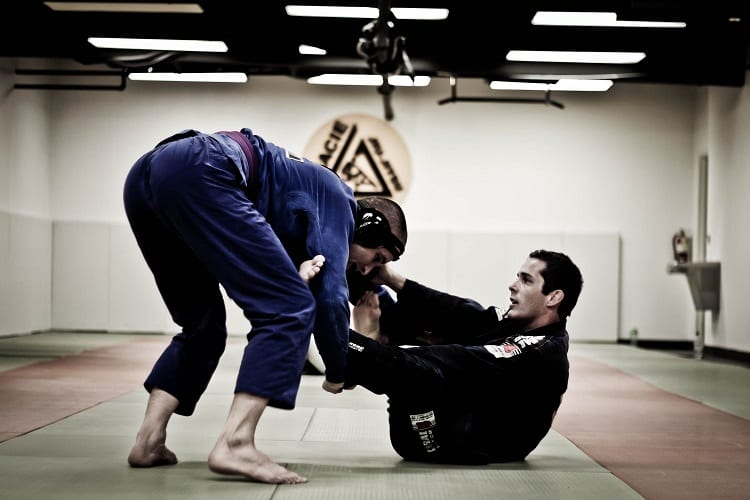
When you’re in active training for Brazilian Jiu-Jitsu, it’s essential to have a strength and conditioning routine in place to follow.
No matter your ranking or skill level, being a stronger and faster player will give you an undeniable advantage over your opponent, which makes you harder to submit and control.
A BJJ competitor will have a training program developed for them by their coaches, but if you’re just getting started in the MMA gym, you’ll want to build on your strength and also increase your aerobic ability.
You could follow a similar plan as a professional athlete, just scaled down to suit the time and capacity that you have, to give you the best chance at success in a competition.
During training for BJJ, you’ll be required to have sparring sessions or to “roll” with other opponents who are also in the training there.
This is where you’ll get real-world experience—and some fun— with grappling and other positions until one player submits the other with a final move on the mat. From there, you’ll learn from your mistakes and determine what worked, giving you more to work with next time.
The Brazilian Jiu-Jitsu Gi and Rankings
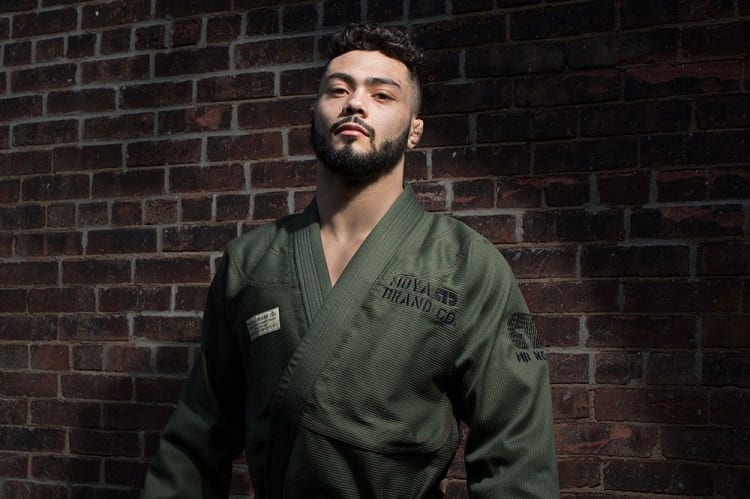
The standard uniform in Brazilian Jiu-Jitsu is called a ‘gi’, and it looks similar to other martial arts uniforms you’ve seen. This garment consists of a jacket, pants, and belt, with some people preferring to wear a rash guard underneath to reduce abrasions and discomfort.
Some training facilities and most individual tournaments will have rules on gi’s standards, with most only allowing white, black, or blue colors. In my experience gi colors only matter in tournaments.
At most gyms, your teacher won’t care a lot about the color of your gi, your overall attitude and devotion to the art is what makes an impression on people.
During tournaments, the pants and tops will have to be the same color, and there should be no patches, designs, or paint on the uniform unless otherwise agreed upon.
The belt of the gi must be colored according to the practitioner’s rank, and always with a black tip unless it is a BJJ black belt, where the tip will be white or red.
Brazilian Jiu-Jitsu Belt System
The ranking system in BJJ works like other martial arts and signifies the competency of a player, their skill level, and technical knowledge.
As you move up the ranks, a new colored belt will be awarded to you, and different levels are depending on whether you’re a child or adult practitioner.
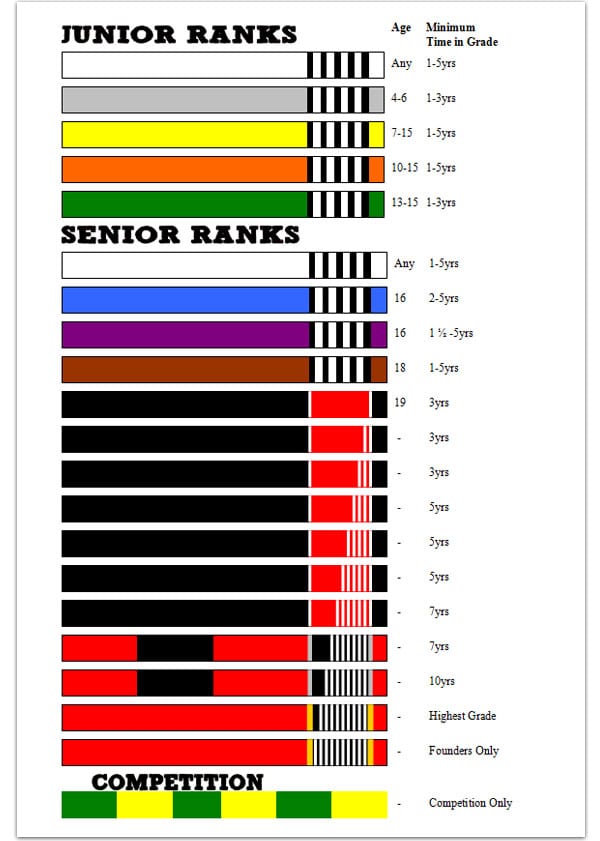
Popular BJJ Competitions
When you’re ready to compete at a serious level, your goal will be to head to one of the biggest BJJ competitions in the world. These are a few of the most coveted Brazilian jiu-jitsu contests and tournaments to give you something to aim for.
The Pan American Championships
Competing and winning the Pan-Ams is the best way to build momentum leading up to the Mundials. This event is attended by black belts and serious athletes hoping to score a world title.
IBJJF Mundials
This is considered the be-all and end of all BJJ tournaments and attracts practitioners from all over the world. There are no age divisions so fighters are only categorized by their weight and belt ranking.
Brazilian Nationals
Held in the country that started in all, the Brazilian Nationals is a good starting point for the Mundials. This is known as the place to be if you’re hoping to scope out up-and-coming talent in the sport.
Tips for BJJ Beginners
Newcomers to BJJ will likely feel overwhelmed by how much there is to learn about the sport.
When you first step into a training facility, it can be daunting for sure, so we’ve come up with some tips that will help beginners navigate their surroundings.
- Train as often as your schedule permits. Don’t just wait for your one training session a week to practice and get some MMA home gym gear for a home gym that will let you work on your skills in between lessons.
- Keep your toenails and fingernails short so you don’t injure anyone, and make sure your hair is pulled back and out of your face.
- Whether you train with a gi or no-gi, you should always have a clean and fresh uniform on.
- Don’t be afraid to ask questions if you’re feeling uneasy. Everyone has had to start somewhere, so you can speak to an instructor or other participants you train with if you’re lost.
- Understand that drills are just as important as sparring, even if they might not be as much fun. Drilling can be repetitive but it’s how we learn, and you have to be patient when you’re in the beginner stages.
- Give yourself time and patience when you’re learning any new skill, but especially BJJ. There are loads of rules, point systems, methods of scoring, and codes of conduct to learn, and you won’t get it all in a day.
The History and Invention of BJJ
Brazilian Jiu-Jitsu didn’t start out as the sport we know today, nor did it begin in Brazil. The form of martial arts was derived from Judo and Japanese Ju-Jutsu, as was the original Japanese spelling.
Known as a gentle art and a form of self-defense, it first developed in the days of the samurai.
This unique way of grappling and ground fighting was created as a way to strike armored opponents, as the usual methods didn’t work. Therefore, they were able to neutralize their opponents by locking their joints, holding them in submissive positions, and performing throws.
When Judo was created in the late 1880s by Kodokan Judo, it used the teachings that he’d gained from Ju-Jutsu but with a bigger focus on throwing.
From here, the martial art moved to Brazil in the 1900s, and with the chance meeting between one of the groundwork experts and a student who was smaller and weaker than most he had trained, the style was developed to favor the unlikely opponent.
Helpful Brazilian Jiu-Jitsu Articles You Shouldn’t Miss
BJJ Basics – Brazilian Jiu-Jitsu For Dummies FAQ
Brazilian Jiu-Jitsu is just one system made popular in mixed martial arts, and although many of its techniques are about competition rather than real-life combat, it’s a useful skill to have.
We’ve answered some frequently asked questions on BJJ and other styles used in MMA, to give you a better understanding of what they’re all about.
DO YOU NEED A GI FOR BJJ?
If you’re training in Brazilian Jiu-Jitsu, you’ll usually need a gi and belt to do so effectively. This garment is part of the sport and will assist in performing moves, as well as showing your rank.
BJJ practitioners might prefer to wear a rash guard underneath their gi, with some clubs requiring it to compete or train, which can make the garment more comfortable.
If you train at a 10th Planet Jiu-Jitsu facility the gi might no be as necessary but traditionally is an essential part of your BJJ gear.
how hard is it to learn jiu-jitsu?
Depending on your previous experience in martial arts and general level of fitness, you may find it hard to understand the basics of BJJ in the beginning and even uncomfortable to practice. So, yes it is hard but also one of the most regarding martial arts to learn.
The sport focuses a lot on the groundwork and there are rules and a point system to learn, so it can be overwhelming at first for newcomers. With regular practice, you should be proficient enough to enter a contest within two years.
Why is BJJ so effective?
BJJ is effective because it teaches a straightforward combat system based on leverage over brute force to attain success. on top of that, practitioners constantly train against resistant opponents.
All BJJ practitioners follow the same blueprint. Take the opponent down, pass the guard, get to a dominant position, control, and submit.
do you wash jiu-jitsu belts?
Yes, you can and should wash your BJJ belts. Old school guys used to believe that you never washed your belt as a badge of honor. It was the way they rolled. But in modern BJJ, that’s not a thing anymore. Please wash your belt when you feel it is too dirty.
do you need to be flexible for bjj?
You don’t need to be flexible for BJJ. You can adapt the techniques to your body’s flexibility. But, like any other sport, your ability to excel at it increases the more athletic you are. Therefore, it won’t be harmful if you’re flexible, strong, or fast in Brazilian Jiu-Jitsu.
do you have to compete in BJJ to get belts?
You don’t always need to compete to get BJJ belts. However, some schools might consider how often you compete and how effective you’re in competition to grant you a belt promotion. And other schools might completely ignore it. It all depends on your instructor’s preferred criteria.
are judo throws allowed in BJJ?
Yes, you can do Judo throws in BJJ. You can also use some wrestling techniques to take people down. Which one you choose is up to you.
do you need a mouthguard for bjj?
It is not mandatory but highly recommended to wear a mouthguard in BJJ training. Especially during rolls or when practicing techniques at full speed.
















